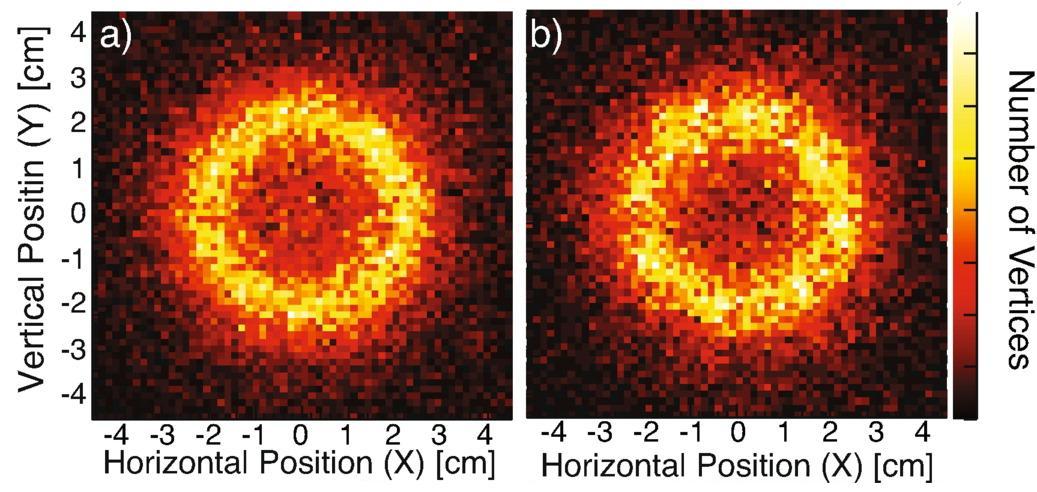Half a dozen TRIUMF scientists contributed to two recently published papers of 35 co-authors setting out to explore a new regime in trap physics using the Antihydrogen Laser Physics Apparatus (ALPHA). The ALPHA experiment is a successor of an earlier antimatter experiment, ATHENA. The overall research goal for ALPHA is to make, capture, and study atoms of antihydrogen and compare these with hydrogen atoms to explore CPT symmetry - a fundamental symmetry of physical laws under transformations that involve the simultaneous inversions of charge, parity, and time.
Creating antihydrogen depends on bringing its two component antiparticles (antiprotons and antielectrons called positrons) together in a device designed to trap charged particles. However, since antihydrogen atoms have no electric charge, they are not confined once produced. ALPHA seeks to trap and hold the antihydrogen atoms, thereby keeping them for a long period of time before they annihilate with ordinary atoms. This special trapping method gives physicists more time to take measurements and probe antihydrogen for answers to the antimatter mystery.
 | |
Azimuthal projections of the antiproton annihilation vertex distribution during mixing with (a) no neutral trap and (b) the full trap. |
The antiprotons used in this project were slowed to the appropriate energies in CERN's Antiproton Decelerator and 'mixed' with positrons from a specially-designed positron accumulator in a versatile Penning-Malmberg trap. This trap is surrounded by a superconducting octupole magnet to form a "minimum-B" magnet trap. Unlike Standard Penning traps, the "minimum-B" trap is able to confine an uncharged particle such as antihydrogen.
In the paper published in October 2009, scientists identified a new particle transport mechanism in a Penning-Malmberg trap based on coupling the non-uniform magnetic field and the non-harmonicity of the electrostatic potential. An understanding of particle transport has many important applications, not least of which is the achievement of antihydrogen trapping.
The subsequent paper published in January 2010 succeeded in demonstrating formation of atoms in a neutral anti-atom trap. Observations of the antihydrogen atoms in the trap were made possible by the detection of annihilations in scintillators and Si vertex detectors, an area for which ALPHA-Canada is making leading contributions. Each detector system is sensitive to the different aspects of antihydrogen formation process, and the combination of the two techniques will allow optimization of the plasma conditions to make trappable antihydrogen atoms.
"The ALPHA collaboration's strength in plasma physics will be critical to our success in trapping antihydrogen" commented TRIUMF scientist Art Olin. "The ability to use antimatter plasmas to identify very small losses has helped to illuminate some very interesting plasma phenomena. ALPHA is a combined effort of plasma, atomic, condensed matter and particle physicists, and it's really exciting to see the synergies that arise from this diversity."
TRIUMF research scientist Makoto Fujiwara is very involved in ALPHA. "These results are important milestones towards our goal of trapping and spectroscopy of antihydrogen. In fact, we have more new results coming out from our recent run. This is an exciting time for antihydrogen physics!"
11 of the 35 co-authors belong to ALPHA-Canada, six of which are affiliated directly with TRIUMF and remaining co-authors affiliated with TRIUMF member and associate universities.
Other partners and member institutions of the ALPHA collaborations include: University of Aarhus, Denmark; Auburn University, USA; University of British Columbia, Canada; University of California, Berkeley, USA; University of Calgary, Canada; University of Liverpool, UK; University of Manitoba, Canada; Negev Nuclear Research Centre, Israel; RIKEN, Japan; Federal University of Rio de Janeiro, Brazil; Swansea University, UK; University of Tokyo, Japan; and Simon Fraser University, Canada.
Magnetic multipole induced zero-rotation frequency bounce-resonant loss in a Penning-Malmberg trap used for antihydrogen trapping. Published online 30 October 2009.
Antihydrogen formation dynamics in a multipolar neutral anti-atom trap. Published online 30 January 2010.
-- Melissa M. Baluk, Communications Assistant with help from ALPHA expert M. Fujiwara.
